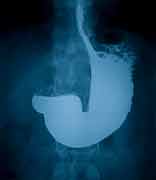Bacteria frequently resistant to clarithromycin, metronidazole, levofloxacin
WEDNESDAY, Oct. 7, 2015 (HealthDay News) — Resistance to the antibiotics clarithromycin, metronidazole, and levofloxacin is high among patients with Helicobacter pylori (H. pylori) infection, according to a study published in the September issue of Clinical Gastroenterology and Hepatology.
Seiji Shiota, M.D., Ph.D., from the Michael E. DeBakey VA Medical Center in Houston, and colleagues assessed the susceptibility of H. pylori to antibiotics among a random sample of 656 patients (90.2 percent men) from a cohort of 1,559 undergoing esophagogastroduodenoscopy with collection of gastric biopsies in a large metropolitan hospital (2009 through 2013). H. pylori was detected using culture analyses of gastric tissue, and the Epsilometer test was used to determine minimum inhibitory concentrations of antibiotics.
The researchers found that 20.6 percent of biopsies tested positive for H. pylori (94.8 percent of these were from males). Only 65 of the 135 positive samples were susceptible to all five antibiotics tested (amoxicillin, clarithromycin, metronidazole, levofloxacin, and tetracycline). Antibiotic resistance ranged from 31.3 percent for levofloxacin, 20.3 percent for metronidazole, 16.4 percent for clarithromycin, to 0.8 percent for tetracycline. No resistance to amoxicillin was detected. Resistance to clarithromycin increased from 9.1 percent (2009-2010) to 24.2 percent (2011-2013). In multivariate analysis, prior treatment of H. pylori infection was significantly associated with clarithromycin resistance, and use of fluoroquinolones was significantly associated with levofloxacin resistance.
“The high frequency of resistance to levofloxacin is a new and concerning finding,” the authors write.
Copyright © 2015 HealthDay. All rights reserved.








